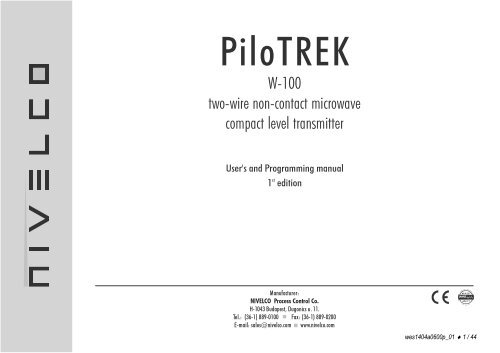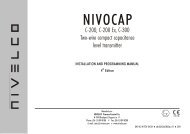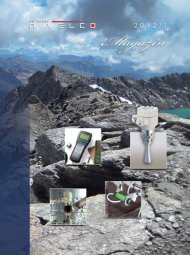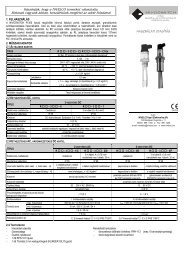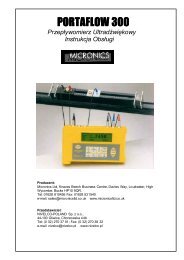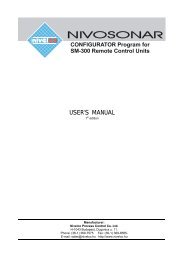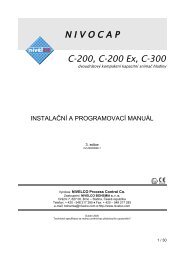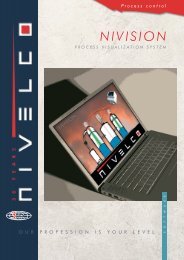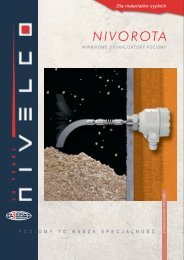PiloTREK W-100 - Nivelco Process Control Co., Inc.
PiloTREK W-100 - Nivelco Process Control Co., Inc.
PiloTREK W-100 - Nivelco Process Control Co., Inc.
Create successful ePaper yourself
Turn your PDF publications into a flip-book with our unique Google optimized e-Paper software.
<strong>PiloTREK</strong>W-<strong>100</strong>two-wire non-contact microwavecompact level transmitterManufacturer:NIVELCO <strong>Process</strong> <strong><strong>Co</strong>ntrol</strong> <strong>Co</strong>.H-1043 Budapest, Dugonics u. 11.Tel.: (36-1) 889-0<strong>100</strong> Fax: (36-1) 889-0200E-mail: sales @nivelco.com www.nivelco.comwes1404a0600p_01 ♦ 1 / 44
wes1404a0600p_01 ♦ 2 / 44BASIC CONCEPTS OF MICROWAVE LEVEL MEASUREMENTUpper dead zone set higherthan the factory default value of P05DIST = measured distanceProgrammedmeasuringrange of theapplicationsLEV = Level (calculated: H - DIST)VOL = Volume (calculated from LEV)Maximum measuring distance of the instrument X MFactory default value of P04Maximum measuring range of the instrumentProgrammed value of P04Minimum measuring distance(dead zone) L minFactory default value of P05
TABLE OF CONTENTS1. INTRODUCTION........................................................................................................................................................................................................................... 52. ORDER CODES............................................................................................................................................................................................................................ 63. TECHNICAL DATA....................................................................................................................................................................................................................... 73.1. DIMENSIONS AND SPECIAL DATA OF THE ANTENNA VARIATIONS.................................................................................................................................................. 83.2. ACCESSORIES ....................................................................................................................................................................................................................... 133.3. CONDITIONS OF SAFE OPERATION .......................................................................................................................................................................................... 133.4. REPAIR AND MAINTENANCE .................................................................................................................................................................................................... 134. INSTALLATION .......................................................................................................................................................................................................................... 144.1. MOUNTING ............................................................................................................................................................................................................................ 144.2. WIRING ................................................................................................................................................................................................................................. 174.2.1. Wiring of <strong>Co</strong>mpact instruments ........................................................................................................................................................................................................ 184.3. LOOP CURRENT CHECKING WITH HAND INSTRUMENT................................................................................................................................................................ 185. PROGRAMMING ........................................................................................................................................................................................................................ 195.1. THE SAP-300 DISPLAY UNIT .................................................................................................................................................................................................. 205.1.1. Primary Measurement Screen ........................................................................................................................................................................................................... 205.1.2. Information Screens ........................................................................................................................................................................................................................... 225.1.3. Echo Map ............................................................................................................................................................................................................................................. 235.2. PROGRAMMING WITH THE SAP-300 DISPLAY MODULE.............................................................................................................................................................. 245.2.1. <strong>Co</strong>mponents of the programming interface .................................................................................................................................................................................... 245.2.2. Menu structure .................................................................................................................................................................................................................................... 255.3. PROGRAMMABLE FEATURES DESCRIPTION .............................................................................................................................................................................. 265.3.1. Basic measurement settings............................................................................................................................................................................................................. 265.3.2. Analogue output ................................................................................................................................................................................................................................. 285.3.3. Digital output....................................................................................................................................................................................................................................... 295.3.4. Measurement optimization ................................................................................................................................................................................................................ 305.3.5. Calculations......................................................................................................................................................................................................................................... 325.3.6. Service functions................................................................................................................................................................................................................................ 366. ERROR CODES.......................................................................................................................................................................................................................... 397. <strong>PiloTREK</strong> W-<strong>100</strong> PARAMETER TABLE.................................................................................................................................................................................... 408. MENUMAP.................................................................................................................................................................................................................................. 42wes1404a0600p_01 ♦ 3 / 44
wes1404a0600p_01 ♦ 4 / 44
Thank you for choosing a NIVELCO instrument.We are sure that you will be satisfied throughout its use!1. INTRODUCTIONApplicationThe <strong>PiloTREK</strong> W-<strong>100</strong> non-contact microwave level transmittersprovide the most advanced, new generation measurement techniqueof the industrial process automation field. <strong>PiloTREK</strong> is an idealsolution of high precision level transmitting of liquids, slurries,dollops, emulsions and other chemicals in a wide range of applicationarea, such as food industry, energy industry, pharmaceuticalindustry, chemical industry, and even in naval applications with mmaccuracy range and high measuring stability.<strong>PiloTREK</strong> is able to provide an excellent non-contact measurementsolution for those substances which tend to steam, or for liquids witha gas layer. Since there is no need for a defined propagation mediumin the case of microwaves, the <strong>PiloTREK</strong> is applicable in vacuum.Operation principleThe reflection of the emitted microwave impulses is considerably depending on therelative dielectric constant of the measured medium. The essential condition ofmicrowave level measurement is that the relative dielectric constant (εr) of themedium should be more than 1.9.The operation of the non-contact microwave level transmitters is based on themeasurement of the time of flight of the reflected signals, so-called Time DomainReflectometry (TDR) method.The propagation speed of microwave impulses is practically the same in air, gasesand in vacuum, independently from the process temperature and pressure, so themeasured distance is not affected by the physical parameters of medium to bemeasured.<strong>PiloTREK</strong> level transmitter is a Pulse Burst Radar operating at 24 GHz (K-band)microwave frequency.The 24 GHz models’ most noticeable advantage over the lower frequency(5-12 GHz) radars are the smaller antenna size, the better focusing, lowerdead-band and smaller transmission angle.The level transmitter induces few nanosecond length microwave impulses in theantenna and a part of the energy of the emitted signals reflects back from themeasurement surface depending on the measured media. The time of flight of thereflected signal is measured and processed by the electronics, and then this isconverted to distance, level or volume proportional data.wes1404a0600p_01 ♦ 5 / 44
2. ORDER CODESNot all combinations possible!<strong>PiloTREK</strong> W – 1 –FUNCTION CODEANTENNA / HOUSINGMATERIALCODEANTENNA /DIAMETERCODEPROCESSCONNECTIONCODE OUTPUT / EX CODETransmitter E 1.4571 / Aluminium housing S DN40 Horn / 1½” 4 BSP 0 4 - 20 mA + HART / normal 4Transmitter + display G 1.4571 / Plastic housing M DN50 Horn / 2” 5 NPT N 4 - 20 mA + HART / Ex 8*High temperaturePP / Plastic housing P DN80 Horn / Flange 8 DN 80 PN25 2HtransmitterDN <strong>100</strong> PN25 3High temperatureDN 125 PN25 4Jtransmitter + displayDN 150 PN25 5DN 80, PP 6DN <strong>100</strong>, PP 7DN 125, PP 8DN 150, PP 9ACCESSORIES:ORDER CODES3” RF 150 psi A4” RF 150 psi BPP antenna enclosure with 1½” BSP threaded process connection WAP-140-0 5” RF 150 psi CPP antenna enclosure with 1½” NPT threaded process connection WAP-14N-0 6” RF 150 psi DPP antenna enclosure with 2” BSP threaded process connection WAP-150-0 3” RF, PP EPP antenna enclosure with 2” NPT threaded process connection WAP-15N-0 4” RF, PP FPTFE antenna enclosure with DN50 (2”) TRICLAMP process connection WAT-14T-0 5” RF, PP GPTFE antenna enclosure with DN50 (2”) Pipe coupling process connection WAT-14R-0 6” RF, PP H * Approval is pendingwes1404a0600p_01 ♦ 6 / 44
3.1. DIMENSIONS AND SPECIAL DATA OF THE ANTENNA VARIATIONSALUMINIUM HOUSING,1½” HORN ANTENNAWES-140-, WGS-140-,WES-14N-, WGS-14N-ALUMINIUM HOUSING,2” HORN ANTENNAWES-150-, WGS-150-WES-15N-, WES-15N-PLASTIC HOUSING,1½” HORN ANTENNAWEM-140-, WGM-140-,WEM-14N-, WGM-14N-PLASTIC HOUSING,2” HORN ANTENNAWEM-150-, WGM-150-WEM-15N-, WGM15N-L MIN LMI N LMINLMINMaterial of wetted parts 1.4571, PTFE 1.4571, PTFE 1.4571, PTFE 1.4571, PTFE<strong>Process</strong> connection 1½” BSP, 1½” NPT 2” BSP, 2” NPT 1½” BSP, 1½” NPT 2” BSP, 2” NPTBeam angle (-3dB) 19° 16° 19° 16°Measuring range (εr = 1,9 ... 4)* 0.2 ... 4.5m 0.2 ... 7m 0.2 ... 4.5m 0.2 ... 7mMeasuring range (εr = 4 ... 10)* 0.2 … 12m 0.2 … 18m 0.2 … 12m 0.2 … 18mMeasuring range (εr > 10)* 0.2 … 18m 0.2 … 23m 0.2 … 18m 0.2 … 23m* LMIN is according to the drawingswes1404a0600p_01 ♦ 8 / 44
ALUMINIUM HOUSING,1½” ANTENNA WITH PP ENCLOSUREWES-140-, WGS-140-+ WAP-140-0, WAP-14N-0PLASTIC HOUSING,1½” PP ENCAPSULATED ANTENNAWEP-140-, WGP-140-WEP-14N-, WGP-14N-ALUMINIUM HOUSING,2” ANTENNA WITH PP ENCLOSUREWES-150-, WGS-150-+ WAP-150-0, WAP-15N-0PLASTIC HOUSING,2” ANTENNA WITH PP ENCLOSUREWEM-150-, WGM-15N-+ WAP-150-0, WAP-15N-0LMI NLMI NLMINLMI NMaterial of wetted parts PP PP PP PP<strong>Process</strong> connection 1½” BSP, 1½”NPT 1½” BSP, 1½”NPT 2” BSP, 2” NPT 2” BSP, 2” NPTMeasuring range (εr = 4 ... 10)* 0.2 … 10m 0.2 … 10m 0.2 … 16m 0.2 … 16mMeasuring range (εr > 10)* 0.2 … 16m 0.2 … 16m 0.2 … 20m 0.2 … 20m* LMIN is according to the drawingswes1404a0600p_01 ♦ 9 / 44
ALUMINIUM HOUSING, 2” TRICLAMPANTENNA WITH PTFE ENCLOSURE,HYGIENIC VERSIONWES-140-, WGS-140-+ WAT-14T-0PLASTIC HOUSING, 2” TRICLAMPANTENNA WITH PTFE ENCLOSURE,HYGIENIC VERSIONWEM-140-, WGM-140-+ WAT-14T-0ALUMINIUM HOUSING,DN50 PIPE COUPLINGANTENNA WITH PTFE ENCLOSURE,HYGIENIC VERSIONWES-140-, WGS-140-+ WAT-14R-0PLASTIC HOUSING,DN50 PIPE COUPLINGANTENNA WITH PTFE ENCLOSURE,HYGIENIC VERSIONWEM-140-, WGM-140-+ WAT-14R-0LMI NLMI NLMI NLMI NMaterial of wetted parts 1.4571, PTFE 1.4571, PTFE 1.4571, PTFE 1.4571, PTFE<strong>Process</strong> connection 2” TRICLAMP 2” TRICLAMP DN50 Pipe coupling (MILCH) DN50 Pipe coupling (MILCH)Measuring range (εr = 4 ... 10)* 0.2 … 10m 0.2 … 10m 0.2 … 10m 0.2 … 10mMeasuring range (εr > 10)* 0.2 … 16m 0.2 … 16m 0.2 … 16m 0.2 … 16m* LMIN is according to the drawingswes1404a0600p_01 ♦ 10 / 44
ALUMINIUM HOUSING,HORN ANTENNA WITH FLANGEWES-18-, WGS-18-LMI NMaterial of wetted parts1.4571, PTFE<strong>Process</strong> connectionFlangeBeam angle (-3dB) 11°Measuring range (εr = 1,9 ... 4)*0.2 … 15mMeasuring range (εr = 4 ... 10)*0.2 … 23mMeasuring range (εr > 10)*0.2 … 23m* LMIN is according to the drawingswes1404a0600p_01 ♦ 11 / 44
HIGH TEMPERATURE VERSION,ALUMINIUM HOUSING,1½” HORN ANTENNAWHS-140-, WHS-140-,WJS-14N-, WJS-14N-HIGH TEMPERATURE VERSION,ALUMINIUM HOUSING,2” HORN ANTENNAWHS-150-, WHS-150-,WJS-15N-, WJS-15N-HIGH TEMPERATURE VERSION,ALUMINIUM HOUSING,HORN ANTENNA WITH FLANGEWHS-18-, WJS-18-HIGH TEMPERATURE VERSION,ALUMINIUM HOUSING, 2” TRICLAMPANTENNA WITH PTFE ENCLOSURE,HYGIENIC VERSIONWHS-140-, WJS-140-+ WAT-14T-0LMI NLMI NLMI NLMI NMaterial of wetted parts 1.4571, PTFE 1.4571, PTFE 1.4571, PTFE 1.4571, PTFE<strong>Process</strong> connection 1½” BSP, 1½”NPT 2” BSP, 2”NPT Flange 2” TRICLAMPBeam angle 19° 16° 11°Measuring range (εr = 1,9 ... 4)* 0.2 ... 4.5m 0.2 ... 7m 0.2 … 15mMeasuring range (εr = 4 ... 10)* 0.2 … 12m 0.2 … 18m 0.2 … 23m 0.2 … 10mMeasuring range (εr > 10)* 0.2 … 18m 0.2 … 23m 0.2 … 23m 0.2 … 16m* LMIN is according to the drawingswes1404a0600p_01 ♦ 12 / 44
3.2. ACCESSORIES• User’s and Programming Manual• Warrant Card• Declaration of <strong>Co</strong>nformity• 2 pcs M20x1.5 cable glands• Sealing (Klinger ® Oilit) only for BSP threaded process connections3.3. CONDITIONS OF SAFE OPERATIONTo avoid the danger of electrostatic charge accumulation, in case of the WP, WM types (with plastic electronic housing or plastic antenna enclosure)the following safety rule shall be observed:• The measured medium should be an electrostatic conductor, and the electrical resistivity of the measured medium cannot exceed 10 4 Ωm.• The speed and the method of the filling and emptying process should be chosen properly according to the measured medium.Meeting the requirements of the technological processPlease carefully consider that all parts of the instrument which possible to come into contact with the measured medium – including the transducer, the sealingand any other mechanical parts – should meet all requirements of the applied technological process, such as the process pressure, temperature and chemicaleffects of the used technologies.3.4. REPAIR AND MAINTENANCEThe <strong>PiloTREK</strong> does not require maintenance on a regular basis.Repairs during or after the warranty period are carried out exclusively at the Manufacturer.The equipment sent back for repairs should be cleaned or neutralised (disinfected) by the User!wes1404a0600p_01 ♦ 13 / 44
4. INSTALLATION4.1. MOUNTINGWhen choosing the installation place please ensure proper space for later calibrations, verification or maintenance service.PLACEMENTThe ideal position for the <strong>PiloTREK</strong> is on ther = (0.3 … 0.5) R (in case of cylindrical tank).It is highly recommended to consider the beamcone on the 1 st page drawing.The distance between the sensor and the tank wallshould be at least 200 mm.If the unit is installed into dome top or sphericaltank, unwanted multiple reflections may appear.MOVING LIQUID SURFACEWaving, vortex or strong vibration effects can havenegative influence on the measurement accuracy.To avoid these effects, the mounting placementshould be as far as possible from the sources ofthese disturbing effects.For example the device should be mounted as faras possible from the filling stream or the tankoutlet.POLARIZATION PLANEThe emitted radar impulses of <strong>PiloTREK</strong> areelectromagnetic waves. The orientation of thepolarization plane is the same as for the electricwave component of the electro-magnetic wave.The rotation of the polarization plane compared tothe tank position could be useful (for example toavoid disturbing reflections) in certain applications.To rotate the polarization plane loosen the M6 hexsocket set screw above the process connectionand rotate the instrument. Then tighten the unit bythe screw.M6/Sw.3wes1404a0600p_01 ♦ 14 / 44
FOAMINGFilling, stirring or any other processes inthe tank can generate dense foams onthe liquid surface, which mayconsiderably damp the reflected signals.According to NIVELCO’s experience, inthese cases the maximal measurementrange decreases by at leastapproximately by 50%.FUMES, VAPOURSIf the measured medium or its foamreaches the antenna or a highly fumingmeasured medium can form deposits onthe sensor, it may result unreliable levelmeasurement.SENSOR ALIGNMENTThe antenna face should be parallel to themedium surface within ± 2-3°.TEMPERATURETo avoid overheating theinstrument should beprotected against directsunshine.Sunshadewes1404a0600p_01 ♦ 15 / 44
OBSTACLESMake sure that no objects (cooling pipes, bracing elements, thermometers, etc.)cross the microwave signals and the instrument has clean view on the medium to bemeasured. Especially in case of extraordinary large silos bracing elements and otherstructural obstacles may cause false reflections which can be damped in mostcases: a small bent metal deflector plate mounted above the obstacle can dispersethe microwave signals and eliminates the false reflections which disturb the reliablemeasurement.If there is no possible mechanical solution to avoid these kinds of false reflections,the programming of the instrument allows blocking out the obstacles. (see: 5.3.4.5)SOCKETThe process connection should be dimensioned that the antenna end shouldprotrude at least 10 mm out of the socket.>10mmwes1404a0600p_01 ♦ 16 / 44
4.2. WIRINGThe instrument operates from 20 … 36 V galvanic isolated and not grounded DCpower supply in two-wire system. (For Ex version: 20 … 28 V DC!)The voltage value measured on the terminal of the instrument should be minimum20 V (in case of 4mA)! In case of using HART interface – to achieve propercommunication between the transmitter’s interface and the power-supply –a minimal 250 Ohm resistance should be maintained within the network. Theinstrument should be wired with shielded cable led through the cable gland. Thewiring of cables can be done after removing the cover of the instrument and the SAPdisplay unit.IMPORTANT: The housing of the transmitter should be grounded to theequipotential network. Resistance of the EP network should be R ≤ 2 Ohmmeasured from the neutral point. Shielding of the cable should be grounded at thecontrol room side to the EP network. To avoid disturbing noises, keep away ofcloseness to high-voltage cables. Especially the inductive couplings of ACharmonics can be critical (which are present at frequency converter control) becauseeven cable shielding does not supply effective protection against these cases.!Display unitconnector1 2 3 4 5 6Loop current4...20 mA loop currentmeasuring connectorand supply (HART)2 53 4U - +1/2” NPT1/2” NPTThe instrument may be damaged by electrostatic discharge (ESD) via its terminal, thus apply the precautions commonly used to avoidelectrostatic discharge e.g. by touching a properly grounded point before removing the cover of the enclosure.A possible electrostatic discharge can cause damage for the instrument. Do not touch the internal terminals!WATER / VAPOURTo achieve suitable ingress protection NIVELCO recommends using the suggestedcable outer diameter (see technical data table in the 3 rd chapter) and fasten properly thecable gland.NIVELCO also recommends leading the connecting cables downwards to lead aside therain water and the condensed water. This is needed in case of outside installations andsome special applications where there is very high humidity or the possibility of watercondensation is quite high (for example in cleaning, purification processes, in cooledand / or heated tanks).M20x1,5RELAYGNDM20x1,5wes1404a0600p_01 ♦ 17 / 44
4.2.1. Wiring of <strong>Co</strong>mpact instrumentsV 200mVExNon-ExExNon-ExMultiCONT24VExcertifiedpowersupplyA250 OhmHARTUsing HART communicationin non-Ex environmentUsing Ex approved instrumentin hazardous environmentUsing MultiCONT process controllerwith Ex approved instrumentin hazardous environment4.3. LOOP CURRENT CHECKING WITH HAND INSTRUMENTAfter removing the cover and the Display Module, the actual loop current can be measured throughout an internal 1 Ohm shunt resistor by connecting avoltmeter (in the range of 200 mV) to the points 2 and 5 indicated on the wiring drawing above.wes1404a0600p_01 ♦ 18 / 44
5. PROGRAMMINGThe <strong>PiloTREK</strong> transmitters can be programmed (basically) with the following two ways:• Programming with the SAP-300 display unit (see 5.2)All features of the unit can be accessed and all parameters can be set, such as measurement configuration and optimisation,outputs, dimensions for 11 tanks with different shape, 99-point linearization.• Programming with MultiCONT process controller or EView2 PC configuration softwareThe <strong>PiloTREK</strong> WG and WJ types include the SAP-300 display unit.The <strong>PiloTREK</strong> transmitters are fully operational without the SAP-300 display as well, it is only needed for local programming and / or local measurementdisplaying.FACTORY DEFAULT SETTINGThe <strong>PiloTREK</strong> W-<strong>100</strong> series level transmitters are factory programmed by the following way:⇒ Measurement mode: Level (LEV). The displayed value is the measured level.⇒ The current output and the bargraph on the right are proportional to the measured level.⇒ 4 mA and 0% are assigned to zero level.⇒ 20 mA and <strong>100</strong>% are assigned to the maximal level.⇒ Error indication by the current output: holding the last value.⇒ Level tracking time constant: 0 sec.The instrument regards the distance (DIST) measured from the antenna end as the basic measurement value. This distance is handled and display in one of theselected dimensions: m, cm, mm, feet, or inch. Since the maximal measurement distance is given (entered in P04) the instrument can calculate the actual level(LEV) value. If the proper mechanical dimensions of the mounting – distance between the sealing and the tank bottom – is known, the measured level valuescan be more accurate by adding this data. The level values calculated that way are the base for volume (VOL) calculation and the 99-point linearization table(VMT) also uses these values as input data.wes1404a0600p_01 ♦ 19 / 44
5.1. THE SAP-300 DISPLAY UNIT5.1.1. Primary Measurement ScreenThe SAP-300 is a 64x128 dot-matrix LCD display which can be plugged into the transmitter. (It is universal – usablein other NIVELCO devices as well – provided that the system software supports SAP-300.)Warning!The SAP-300 module is based on LCD technology, so please make sure it is not exposed to permanent heat ordirect sunlight, in order to avoid damage of the display unit. If the instrument cannot be protected against directsunlight or high temperature that is beyond the standard operating temperature range of the SAP-300, please do notleave the SAP display in the instrument.Measurement displaying with the SAP-300 display unitElements of the displaying:1, Primary (Measured) Value (PV), in accordance to BASIC SETUP / PV. MODE.2, Calculation mode of Primary Value (PV), in accordance to BASIC SETUP / PV. MODE.3, Type and value of the initial quantity used for calculating the Primary Value (PV):- in case of Level measurement (LEV) it is Distance (DIST),- in case of Volume measurement (VOL) it is Level (LEV).4, Trend direction arrows. The empty triangle shows when the change of the measured value is small,the filled triangle shows large-scale change. If none of the arrows are shown the measured value is constant.5, Measured PV (Distance Value) in relation to measurement range (Sensor range) displayed in a bargraph.6, Indication of Primary Value simulation. In this case the display and output show the values of thesimulation and not the measured values.7, Indication of active (Volume / Mass Table - VMT) calculation mode.During active simulation the critical measurement errors will be displayed to give information to the user.4542 3L:2.345mVOL SIM6 1 C.0FVMT m 3Io: 12.00mA M7ABwes1404a0600p_01 ♦ 20 / 44
A, Calculated value of the output current.After the dimension, the mode of current output is indicated by inverse inscription:MManual mode (see 5.3.2.1)HHART address is not 0, so output current has become overwritten to 4mA (see 5.3.2.1)E!Analogue transmission reacts to a programmed failure conditionif an upper or lower fault current is programmed (see 5.3.2.4)B, Output range (4-20mA) indicated in a bargraph.The bottom of the bargraph is assigned to 4mA and the top is assigned to 20mA.C, Indication of Menu Lock: If key symbol is visible, the unit is protected with a password. When entering the menu, theinstrument asks for the correct password (see 5.3.6.1). If REM message is visible, the instrument is in remote programming mode and the main menucannot be accessed.Errors occurred during the measurement can be seen at the bottom line of the display.wes1404a0600p_01 ♦ 21 / 44
5.1.2. Information ScreensPress button to cycle between the information displays:1. General information display (DEV. INFO)Overall running time (OV. RUN TIME)Run time after power on (RUN TIME)Type of interface (INTERFACE) in the instrument.Type of the instrument (TYPE)2. Sensor information: (SENSOR INFO)Number of echoes (ECHO TOT/SEL)Blocking (BLOCKING)Signal-to-noise ratio (SN)Temperature (TEMP)3. Echo table: (ECHO TABLE)The informative screen returns back to main screen after 30 seconds.By pressing the button the user can return to the main screen any time.Pressing the E button in any of the screens the user can enter the main menu.After exiting the menu always the main screen will be shown.L:2.345mVOL SIM0Io: 12.00mAF200.000m 3- DEV. INFO ---0:1.00OV. RUN TIME: 1.0hRUN TIME: 0.1hINTERFACE: HARTRELAY: YESLOGGER: NO--- SENSOR INFO -----ECHO TOT/SEL: 01/01POS. OF WIND: 14SN RATION: 28BLOCKING: 10DMEM_BASE: 12TEMP: 26.2m/M TEMP: 0.00/26.2M--- ECHO LIST -----No. --Dist. – Amp. -00. 00.550 35.001. 00.000 00.002. 00.000 00.003. 00.000 00.004. 00.000 00.0wes1404a0600p_01 ♦ 22 / 44
5.1.3. Echo MapPressing the button in the measurement screen the echo map screen willappear. This screen shows the following information:1. Echo diagram2. Actual measured distance3. Maximal measuring rangeD:2177mmDISTIo: 12.00mA2177mmMThe echo map screen returns back to main screen after 30 seconds.By pressing the button the user can return to the main screen any time.Pressing the E button in any of the screens the user can enter main menu.After exiting the menu always the main screen will be shown.ECHO MAPEcho diagram2177mm 6000Measured distanceMaximal measuring rangewes1404a0600p_01 ♦ 23 / 44
5.2. PROGRAMMING WITH THE SAP-300 DISPLAY MODULEWhen entering the menu the instrument makes a copy of the actual parameters and all changes are done to this duplicated parameter set. During programmingthe instrument keeps measuring and transmitting with the current (and intact) parameter set. After exiting the menu the instrument replaces the originalparameters with the new parameter set and will measure according to the new parameters. This means that the change of the parameters does not becomeimmediately effective when pressing the E button!Entering the menu can be done by pressing the E button, while exiting the menu can be done by pressing the button.If the instrument is left in programming mode after 30 minutes it will automatically return to measuring mode. If the SAP-300 display is removed duringprogramming the instrument immediately returns to measuring mode.As programming with SAP-300 (manual programming) and HART (remote mode) programming is not possible at the same time, only one programming methodcould be chosen. Measured values can be read out through HART at any time.5.2.1. <strong>Co</strong>mponents of the programming interfaceThe parameters of the instrument are grouped according to their functions. The programming interface consists of lists, dialog windows, edit windows and reportwindows.Lists1Navigation between the lines of a list can be done by pressing / buttons. Pressing the E buttonactivates a list item. Selected list item is marked with inverse colour. Exit from a list by pressing the button.Menu listMenu list is a specialized list. Its characteristic is that upon selecting a list item we directly get into another list,and these lists are opening from each other in different levels.The menu header (1) helps to navigate.Entering the main menu can be done by pressing the E button. Navigation between the menu items can bedone by pressing the / buttons. Enter to the selected menu by pressing the E button. The selected listitem is marked with inverse colour.Exit from a submenu by pressing the button. Pressing the button in the main menu will quit from theprogramming mode and the instrument will return to measuring mode.MAIN MENUBASIC SETUPOUTPUT SETUPOPTIMIZATIONCALCULATIONSERVICEwes1404a0600p_01 ♦ 24 / 44
Dialog windowDuring the programming the system sends messages or warnings to the users by dialog windows. Theseusually can be acknowledged by pressing the button or the user can choose between two options (usuallyYES or NO) by pressing / buttons. In some cases one of the parameters has to be changed to correct anerror.WARNINGLOAD DEFAULT TOPARAMETER TABLE!ARE YOU SURE?[YES][NO]Edit windowAn edit window is used for modifying a numeric parameter value. The selected character can be changed usingthe / buttons. The cursor can be moved to left, using the button.The direction of the cursor movement through the digits is right to left. Changed value can be validated bypressing the E button. The software checks if the entered value is appropriate, exiting the edit window is onlypossible after entering a correct value. If the entered value is uninterpretable the software sends an errormessage in the bottom line (1) of the display.Edit window – button combinationsIn the edit window the following button combinations are available:1. - Recalling the parameters to the state before editing ( + , pressed for 3 secs);2. - Recalling default parameters ( + , pressed for 3 secs);3. - Inserting (currently) measured value to the edit window ( + , pressed for 3 secs)Only for certain parameters!ANALOG OUTPUTPARAMETER EDITOR4mA VALUE:16.000WRONG VALUE!1E123m5.2.2. Menu structureMain menuBASIC SETUPOUTPUT SETUPOPTIMIZATIONCALCULATIONSERVICEParameter group of the basic measurement parametersParameter group of the output parametersParameter group for measurement optimization settingsCalculationsService functions, calibration, test and simulationwes1404a0600p_01 ♦ 25 / 44
5.3. PROGRAMMABLE FEATURES DESCRIPTION5.3.1. Basic measurement settings5.3.1.1 Default unit systemParameter: P00: c, where c: 0, 1. Default value: EUPath: BASIC SETUP / UNITS / ENGINEERING SYSTEMDescription:This should be configured as the first step of the programming.Here you can choose the default unit system:• EU European unit system• US Anglo-Saxon / American unit system5.3.1.2 Dimension of the default unit systemParameter: P00: b, and P02: b, or P02: c Default value: mm, m 3 , tPath: BASIC SETUP / UNITS / ENGINEERING UNITSDescription:The dimension of the selected default unit system can be specified in this menu. Theselected measurement mode here will define the primary measured value and the displayedvalue, furthermore it will be the source for the current output.• BASIC UNITS (m, cm, mm, ft, inch )• VOLUME / FLOW UNITS (m 3 , l, ft 3 , gallon)• MASS UNITS (t, t)• TOT UNITS (m 3 , l, ft 3 , gallon)• TOT UNITS (sec, min, hour, day)If the dimension is modified, the device resets all the parameters after a warning message.wes1404a0600p_01 ♦ 26 / 44
5.3.1.3 Primary Value ModeParameter: P01: b a Default value: DISTPath: BASIC SETUP / PV MODEDescription:This mode determines the primary value and the displayed value. It also determines thevalue which will be proportional to the output current.• DISTANCE• LEVEL• VOLUME• MASS5.3.1.4 Maximal Measuring DistanceParameter: P04 Default value:Path: BASIC SETUP / MAX. MEAS.DISTDescription:This parameter should be entered all the cases, except distance measurement mode. But itis suggested to be programmed in case of distance measurements in order to avoid thedisturbing effects of possible unwanted multiple reflections.5.3.1.5 Damping TimeParameter: P20 Default value: 0 secPath: BASIC SETUP / DAMPING TIMEDescription:Damping time is used to damp the unwanted fluctuations of the output and display.If the measured value changes rapidly the new value will settle with 1% accuracy after thisset time. (Damping is according to the exponential function).5.3.1.6 Demo ModeParameter: P00: d Default value: OFFPath: BASIC SETUP / DEMO MODEwes1404a0600p_01 ♦ 27 / 44
Description: • OFF: The operation is performed with considering all the application parameters(such as filling, emptying speed, echo selection, etc..)• ON: This fast operation mode ignores the application parameters. The demomode uses a fast algorithm evaluation independently from P25, P26 and P27parameters. The measurement accuracy and reliable operation between processenvironments are not guaranteed!5.3.2. Analogue output5.3.2.1 Output Current ModeParameter: P12:b, where b: 0, 1. Default value: AUTOPath: OUTPUT SETUP / ANALOG OUTPUT / CURRENT MODEDescription:Transmission mode of the current output.• AUTOThe output current is calculated from the measured value, output isactive.• MANUAL The output current is fixed at a constant (set) value (see 5.3.2.5). In thismode the setting of the error current is irrelevant. The set (current) valueoverwrites the 4mA output of HART multidrop mode!5.3.2.2 Output Current Value assigned to 4mAParameter: P10 Default value: 0 mmPath: OUTPUT SETUP / ANALOG OUTPUT / 4mA VALUEDescription:Measured value assigned to 4mA current value.The transmitted value is in accordance to the primary value (PV) (P01:a). Assignment canbe done that the change in measured value and the change in the output value are thesame (normal), or opposite directional (inverse operation). For example: 1m level is 4 mA,10m level is 20mA, or 1m level is 20mA and 10m level is 4mA.5.3.2.3 Output Current Value assigned to 20mAParameter: P11 Default value:Path: OUTPUT SETUP / ANALOG OUTPUT / 20mA VALUE Maximal measurement range (mm)wes1404a0600p_01 ♦ 28 / 44
Description:Measured value assigned to 20mA current value.The transmitted value is in accordance to the primary value (PV) (P01: a). Assignment canbe done that the change in measured value and the change in the output value are thesame (normal), or opposite directional (inverse operation). For example: 1m level is 4mA,10m level is 20mA, or 1m level is 20mA and 10m level is 4mA.5.3.2.4 Output Current Error ModeParameter: P12:a, where a: 0, 1, 2 Default value: HOLDPath: OUTPUT SETUP / ANALOG OUTPUT / ERROR MODEDescription:Error indication by the current output:• HOLD Error indication has no effect on the output current.• 3.8mA Error indication: the output current gets 3.8mA.• 22mA Error indication: the output current gets 22mA.Warning: This error indication is active unless the failure is fixed, or until the failureterminates.5.3.2.5 Fixed Output CurrentParameter: P08 Default value: 4 mAPath: OUTPUT SETUP / ANALOG OUTPUT / MANUAL VALUEDescription:Parameter for setting the fixed output current:Values between 3.8 and 20.5 can be entered. The output current will be set to the enteredvalue and analogue transmission will be suspended (see: 5.3.2.1). This error indicationoverrides all other error indication.5.3.3. Digital output5.3.3.1 HART Polling AddressParameter: P19 Default value: 0Path: OUTPUT SETUP / SERIAL OUTPUT / ADDRESSwes1404a0600p_01 ♦ 29 / 44
Description:HART Polling AddressThe polling address can be set between 0 and 15. For a single instrument the pollingaddress is 0 and the output is 4-20mA (analogue output). If multiple units are used in HARTMultidrop mode (max. 15 pcs.) the polling addresses should differ from 0 (1-15), in this casethe output current will be fixed at 4mA.5.3.4. Measurement optimization5.3.4.1 Blocking, Dead ZoneParameter: P05 Default value: 200 mmPath: OPTIMIZATION / DEAD ZONEDescription:The instrument ignores all reflections within the dead zone and the close-end blockingdistance. The disturbing objects and false reflections which are close to the sensor can beeliminated by entering the dead zone value manually.5.3.4.2 Echo SelectionParameter: P25:a, where a: 0, 1, 2, 3 Default value: AUTOPath: OPTIMIZATION / ECHO SELECTIONDescription:Selection of Echo within the measuring window. In order to avoid disturbing reflections theinstrument forms a so-called measuring window around the reflected signal. The distancemeasurement is performed with the echo signal within the measurement window.• AUTO• FIRST• HIGHEST AMPLITUDE• LAST5.3.4.3 Emptying SpeedParameter: P27 Default value: 5000 m/hPath: OPTIMIZATION / EMPTYING SPEEDDescription:This parameter provides additional protection against echo loss in applications involvingvery heavy fuming during emptying process. <strong>Co</strong>rrect setting increases the reliability of themeasurement during the emptying. The parameter must not be smaller than the fastestpossible emptying rate of the actual technology.wes1404a0600p_01 ♦ 30 / 44
5.3.4.4 Filling SpeedParameter: P26 Default value: 5000 m/hPath: OPTIMIZATION / FILLING SPEEDDescription:This parameter provides additional protection against echo loss in applications involvingvery heavy fuming during filling process. <strong>Co</strong>rrect setting increases the reliability of themeasurement during the filling. The parameter must not be smaller than the fastest possiblefilling rate of the actual technology.5.3.4.5 Background Echo ImagePath: OPTIMIZATION / BACKG.ECHO IMAGE / SAVE BACKG. IMAGEDescription:Blocking out disturbing objects. The not-moving disturbing objects inside the tank whichgenerates unwanted false reflections can be blocked out from the measurement range. Forthis purpose the instrument needs to map the totally empty tank to create a ”backgroundimage”. After this procedure the software will automatically recognise and ignore thereflections coming from the disturbing objects crossing the microwave beam(see 4.1 - Obstacles).Clear saved background imageBACKGROUND IMG.RANGE:SR BKG.:LG BKG.:[QUIT][CLEAR]SHORTNONO[SAVE]Indication of short or long background imageSaved short background imageSaved long background imageQuitSave background imagewes1404a0600p_01 ♦ 31 / 44
5.3.4.6 Using saved background imageParameter: P35: a, where a: 0, 1 Default value: OFFPath: OPTIMIZATION / BACKG.ECHO IMAGE / SAVE BACKG: IMAGEDescription:Turning ON or OFF the usage of saved background image during the calculations as perthe above 5.3.4.5 point described.• OFF: Ignoring the saved background image.• ON: Saving background image, damping reflections coming from the disturbing objects.5.3.4.7 Threshold valueParameter: P29 Default value: 3 dBPath: OPTIMIZATION / THRESHOLD VALUEDescription:Defining an upper limit value above the saved background image described in 5.3.4.5 point.The instrument will evaluate the measurement result as a real echo when the reflectedsignal exceeds the saved background level with the threshold value entered here. Settingthe threshold value is useful when the level in the tank and the position of the (smallsurface) not-moving disturbing object are the same. This case the instrument will notregards the echo signal as false reflection.5.3.5. Calculations5.3.5.1 Specific gravityParameter: P32 Default value: 0Path: CALCULATION / SPECIFIC GRAVITYDescription:Entering a value (other than “0”) of specific gravity in this parameter, the MASS value will bedisplayed instead of Volume (VOL) in the dimension of tonne or lb/tonne depending on P00(c) and P02 (b).5.3.5.2 Volume / Mass Calculation ModeParameter: P47: a Default value: 0Path: CALCULATION / V/M CALC. MODEDescription:wes1404a0600p_01 ♦ 32 / 44Calculation of the volume and mass can be performed with two ways:• TANK FUNCTION/SHAPE – volume and mass calculation with a tank shapeformula. Entering this menu point the table is automatically OFF.• V/M TABLE – volume and mass calculation with a table.Entering this menu point the table is automatically ON
5.3.5.3 Volume / Mass TableParameter: -Path:CALCULATION / V/M CALC. MODE / V/M TABLEDescription: • VIEW/EDIT TABLE• ADD ITEM• DELETE ITEMIf none of the formulas match perfectly to the characteristics of the needed tank, there is a possibility to use tablecalculation mode. The device can handle a 99-point table on this purpose and counts values between theneighbouring point pairs with linear interpolation.The input (left) side of the table contains the level data, the output (right) side contains the volume or mass data.The first point pair of the table should be 0,0. If a long table wanted to be shortened, 0,0 point pair should be enteredinto the last item of the table and the device modifies the unused point pairs automatically in the background to 0,0.The status (ON or OFF) of the table is shown on a warning message (1) on the bottom line of the display.All modifications are done on a temporary table. This temporary table becomes valid after exiting.Modifications during the programming procedure have no effect on the measurement and the transmitting.Entering the point pairs can be done in arbitrary order, because the device sorts according to ascending order. Bothsides of the table have to be strictly monotonic increasing. In case of any error, warning message (see: 6 th chapter)will appear. When entering again the table an inscription indicates the first wrong line.View table:In VIEW/EDIT TABLE menu point items of the ordered table can be checked. For moving in the list use the andbuttons, for editing the selected item use the E button. Exiting from the list can be done by pressing the button.Edit table:Adding a point pair (ADD ITEM) to the list or pressing E button on an existing item, an edit screen will appear. In thisedit screen there are two editing filed. Both editing field works as same as editing a parameter. Getting from the firstfield to the second field press the E button. Pressing E button in the second field will return back to the previousmenu point. When exiting from the last field, the device performs the ordering of the table.Delete itemMoving in the list can be done with and buttons, for deleting an item press the E button on the selected item.Exiting from the list can be done by pressing the button. The table should contain at least 2 items.1V/ M CALC . MODETANK FUNCTION /SHAPEV/ M TABLEVMT IS ACTIVEEDIT/VIEW TABLE01: 0000 .0 000000 .00002: 0<strong>100</strong> .0 000<strong>100</strong> .00002. VM TABLE ITEMLEVEL VALUE : cm0012.0V/M VALUE : m 3095310.00001: 0000 .0 000000 .000DELETE ITEM02: 0<strong>100</strong> .0 000<strong>100</strong> .000wes1404a0600p_01 ♦ 33 / 44
5.3.5.4 Tank Functions / ShapeParameter: P40: a, where a: 0,1, 2, 3, 4. Default value: 0Path: CALCULATION / V/M CALC. MODE / TANK FUNCTION/SHAPEDescription: • STANDING CYL.: Standing cylindrical tank• STD. CYL. CON. BOT.: Standing cylindrical tank with conical bottom• STD. RECT. W/CHUTE: Standing rectangular tank with or without chute• LYING CYLINDRICAL: Lying cylindrical tank• SPHERICAL: Spherical tank5.3.5.5 Tank Bottom ShapeParameter: P40: b, where b: 0,1, 2, 3 Default value: 0Path: CALCULATION / V/M CALC. MODE / TANK FUNCTION/SHAPEDescription:This menu only appears, if it has an importance on the selected tank shape type!• SHAPE0• SHAPE1• SHAPE2• SHAPE35.3.5.6 Tank DimensionsParameter: P41- P45 Default value: 0Path: CALCULATION / V/M CALC. MODE / TANK FUNCTION/SHAPEDescription: • DIM1 (P41)• DIM2 (P42)• DIM3 (P43)• DIM4 (P44)• DIM5 (P45)wes1404a0600p_01 ♦ 34 / 44
Standing cylindrical tank withhemispherical bottom a = 0Standing cylindrical tank withconical bottom a = 1 ; b = 0Standing rectangular tank withor without chute a = 2 ; b = 1P41P41P41P42P40b=3b=0b=1b=2P43P44P43P44P45If no chute: P43, P44and P45 = 0Lying cylindrical tank a = 3Spherical tank a = 4 ; b = 0P40b=3b=2b=1b=0P41P42P41wes1404a0600p_01 ♦ 35 / 44
5.3.6. Service functions5.3.6.1 Security <strong>Co</strong>desUser codesPath:SERVICE / SECURITY / USER LOCKDescription:Setting or unlocking the user security code.The instrument can be protected against unauthorized programming with a 4 digit PIN (Personal Identification Number) code. If eitherof the digits differs from 0 the code is active. If zero is specified, then the secret code has been deleted!In case of Active code, this code is requested at menu entry.Service codePath:SERVICE / SECURITY / SERVICE LOCKDescription:Setting of the service code.Only for trained personnel!5.3.6.2 Current Output TestParameter:P80Path:SERVICE / OUTPUT TEST / ANALOG OUTPUT / CURRENT VALUEDescription:Loop current test (mA)Entering this Parameter the current value which is proportional to the actual measurement value will appear on the display and theoutput. In loop current test mode, values between 3.9 and 20.5 can be entered. The output current will be set to the entered value. Themeasured current on the output should be equal to the set value.In test mode a dialog window warns the user of the fixed output current until the user exits the warning message window.Exiting can be done by pressing the E button.wes1404a0600p_01 ♦ 36 / 44
5.3.6.3 Distance SimulationThis function facilitates the user to be able to check the calculations (tank formula, table), outputs, and the additional processing instruments connected to theoutput. <strong>PiloTREK</strong> transmitters can perform simulation on the value of a constant or a variable. To start simulation the instrument must return to Measurementmode. In Measurement mode if simulation is in progress, an inverse SIM caption appears on the display.Simulation modeParameter: P84:a, where a: 0,1, 2, 3, 4 Default value: OFFPath: SERVICE / DIST SIMULATION / MODEDescription: Simulation mode:OFF No simulationFIX VALUEValue of the simulated distance is set according to the lowestvalue of the simulation.MANUAL VALUETRIANGLE WAVE….Value of the simulated distance changes linearly between thelowest and highest values with an adjustable cycle time.DISTSimulation cycleSQUARE WAVEThe simulated value jumps between the lowest and highestvalues with an adjustable cycle time.Parameter: P85 Default value: 60 secPath: SERVICE / DIST. SIMULATION / TIMEDescription: Cycle time of the simulationBottom value of the simulationParameter: P86 Default value: 0 mmPath: SERVICE / DIST. SIMULATION / BOTTOM VALUEDescription: Lowest value of the simulationCycle timeUpper value of the simulationParameter: P87 Default value:Path:SERVICE / SIMULATION / UPPER VALUEDescription: Highest value of the simulationt [sec]Programmedmeasurementrangewes1404a0600p_01 ♦ 37 / 44
5.3.6.4 Load Default ValuesPath:SERVICE / DEFAULTS / LOAD DEFAULTDescription:This command loads all default values of the instrument.After loading the default values the parameters can freely be changed, the effect of the changes does not affect on the measurementuntil the user exits from the Programming mode and returns to Measurement mode. Before loading the defaults the software asks for aconfirmation from the user because all user parameters will be lost!wes1404a0600p_01 ♦ 38 / 44
6. ERROR CODESMESSAGE ON THE SCREEN ERROR DESCRIPTION PROCEDURE TO DO CODEMEMORY ERROR Memory error in the electronics <strong>Co</strong>ntact the service! 1NO INPUT SIGNAL Sensor error <strong>Co</strong>ntact the service! 2EE COM. ERROR Hardware error (EEPROM communication error) <strong>Co</strong>ntact the service! 3MATH. OVERLOAD Display overflow Check the programming! 4SIGNAL IN N.D.B.Sensor or calibration error(Measured value is in the close-end dead-zone)<strong>Co</strong>ntact the service!! 5SIGNAL IN F.D.B.Sensor or calibration error(Measured value is in the far-blocking zone)Check the installation conditions! 7VMT SIZE ERROR Linearization error: Less than two items are in the table. Check the content of the VMT! See: 5.3.5.3. 12VMT INPUT ERRORLinearization table error: monotonicity error in the input (level)Check the content of the VMT! See: 5.3.5.3. 13VMT OUTPUT ERRORVMT INPUT OV.RNG.EE CHK ERRORINTEGRITY ERRORside of the table.Linearization table error: monotonicity error in the output (volumeor mass) side of the table.Linearization table error: The measured level is greater than thehighest level of the table’s input side.Parameter checksum error.<strong>Inc</strong>orrect parameter values. Stored parameters are damaged.(Automatically corrected internal error).Only WARNING message.Check the content of the VMT! See: 5.3.5.3. 14Check the content of the VMT! See: 5.3.5.3.Device performs extrapolation according to the lastpoint pairs!Check the programming!For recalculate the checksum modify a parameter andreturn to Measurement mode.If this error still remains, contact the service!Check the programming! 17AC COM. ERROR Hardware error <strong>Co</strong>ntact the service! 18CALIBRATION ERROR Sensor calibration error <strong>Co</strong>ntact the service!1516wes1404a0600p_01 ♦ 39 / 44
7. <strong>PiloTREK</strong> W-<strong>100</strong> PARAMETER TABLEPxx Parameter name d c b a00 Engineering system, dimensions DEMO mode0 = Normal mode1 = Demo modeEngineering system:0 = EU1 = USDimension:(EU) 0 = m, 1 = cm, 2 = mm(US) 0 = ft, 1 = inch01 Source of Primary Value (PV) 0 = DIST, 1 = LEVEL, 2 =VOLUME, 3 = MASS02 Applicable dimensions TOT units:(TOT-EU) 0 = m 3 , 1=litre(TOT-US) 0 = ft 3 , 1 =USgallonwes1404a0600p_01 ♦ 40 / 44Time units:0 = sec1 = min2 = hour3 =day(VOL/F-EU)0 = m 3 , 1=litre(VOL/F-US)0 = ft 3 , 1 = US gallon(MASS-EU)0 = tonne, 1= US tonne(MASS-US)0 = tonne, 1 =lb(pound)04 Max. measuring distance FLOAT05 Blocking / DEAD ZONE FLOAT08 Fix current output FLOAT (3.8-22 mA)10 4mA FLOAT11 20mA FLOAT12 Output current mode Operation mode:0= AUTO1= MANUAL19 HART polling address ULONG20 FILTER (damping time) ULONG (0-999 sec)25 Echo selection in the measuringwindow26 Filling speed FLOAT27 Emptying speed FLOAT29 Threshold value FLOAT (0 - 6 dB)32 Specific gravity of the medium FLOATTemperature unit:0 = °CError indicationof the current output:0 = HOLD1 = 3.8mA2 = 22mA0 = AUTO1 = FIRST2 = HIGHEST AMPLITUDE3 = LAST
35 Background mode Background echo processing mode:0 = OFF1 = ON40 Tank shape 0 = Standing cylindrical tank withdome bottom1 = Standing cylindrical tank withconical bottom2 = Standing rectangular tank withor without chute3 = Lying cylindrical tank4 = Spherical tank41-45 Tank dimensions47 VMT mode Operation of the linearization:0 = OFF, 1 = ON60 Overall runtime ULONG61 Runtime after last reset ULONG70 Number of echoes ULONG71 Position of the measuring ULONGwindow74 Singal-to-noise ratio FLOAT75 Blocking distance value FLOAT80 Current output test FLOAT (3.8-22 mA)84 Simulation Distance simulation mode:0 = No simulation1 = Fix value2 = Simulation with a manual value:PV=a entered in P863= Simulation between P86 and P87levels with P85 cycle time(triangle wave)4= Simulation between P86 and P87levels with P85 cycle time(square wave)85 Cycle time of DIST simulation ULONG [sec]86 Bottom value of the simulation FLOAT87 Upper value of the simulation FLOATwes1404a0600p_01 ♦ 41 / 44
MAIN MENU-------------------------BASIC SETUPOUTPUT SETUPCALCULATIONSERVICEBASIC SETUP-------------------------PV. MODEUNITSDAMPING TIMEPV. MODE-------------------------DISTLEVELVOL*MASS**UNITS-------------------------ENGINEERING SYSTEMENGINEERING UNITSENGINEERINGSYSTEM-------------------------EUUSENGINEERING UNITS-------------------------BASIC UNITSVOLUME UNITS**MASS UNITSBASIC UNITS-------------------------METER / FTCM / INCHMMVOLUME UNITS-------------------------3 3M / ftLITER / GALLONMASS UNITS-------------------------METR. TON / IMP. TON- / lb (POUND)DAMPING TIMEOUTPUT SETUP-------------------------ANALOG OUTPUTSERIAL OUTPUTANALOG OUTPUT-------------------------CURRENT MODE4mA VALUE20mA VALUEERROR MODEMANUAL VALUECURRENT MODE-------------------------AUTOMANUAL4 mA VALUE20 mA VALUEERROR MODE-------------------------HOLD3.8 mA22 mASERIAL OUTPUT-------------------------ADDRESSMANUAL VALUEADDRESS8. MENUMAPwes1404a0600p_01 ♦ 42 / 44
wes1404a0600p_01 ♦ 43 / 44CALCUALTION-------------------------LEVEL OFFSET*V / M CALC. MODE**SPECIFIC GRAVITYLEVEL OFFSETSPECIFIC GRAVITYV / M VALC MODE(P47)-------------------------TANK FUNCTION / SHAPEV / M TABLEMODIFY?"ARE YOU SURE?"V / M TABLE-------------------------VIEW / EDIT TABLEADD ITEMDELETE ITEMTANK FUNCTION / SHAPE-------------------------STANDING CYLSTD. CYL. CON. BOT.STD. RECT. W / CHUTELYING CYLINDARSPHERICALBOTTOM SHAPE-------------------------SHAPE0SHAPE1SHAPE2SHAPE3TANK DIMENSIONS-------------------------DIM 1DIM 2DIM 3DIM 4DIM 5DIMxSERVICE-------------------------SECURITYOUTPUT TESTDIST SIMULATIONDEFAULTSSERVICE DIST OFFSETRESTARTSECURITY-------------------------USER LOCKSERVICE LOCKOUTPUT TEST-------------------------ANALOG OUTPUTSERIAL OUTPUTDIST SIMULATION-------------------------MODETIMEBOTTOM VALUEUPPER VALUEUSER LOCKSERVICE LOCKCURRENT VALUESERIAL OUTPUT-------------------------1200Hz2200HzMODE-------------------------OFFMANUAL VALUETRIANGLE WAVESQUARE WAVETIMEBOTTOM VALUEDEFAULTS-------------------------LOAD DEFAULTSCLEAR TIMERSUPPER VALUELOAD DEFAULT"ARE YOU SURE?"CLEAR TIMERS"ARE YOU SURE?"SERVICE DIST OFFSET
wes1404a0600p_01 ♦ 44 / 44wes1404a0600p_01.doc2012. NovemberNIVELCO reserves the right to change technical data without notice!


